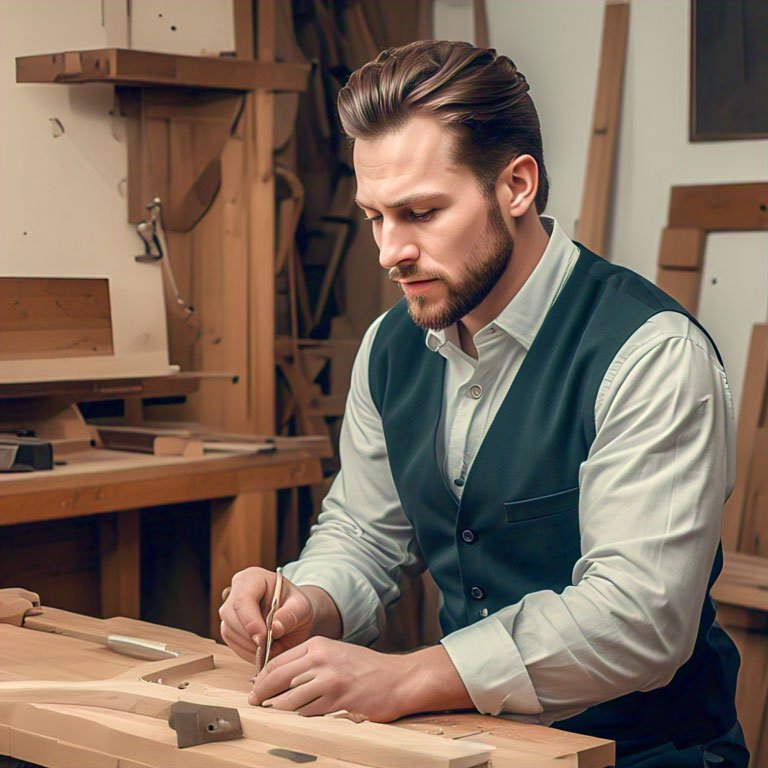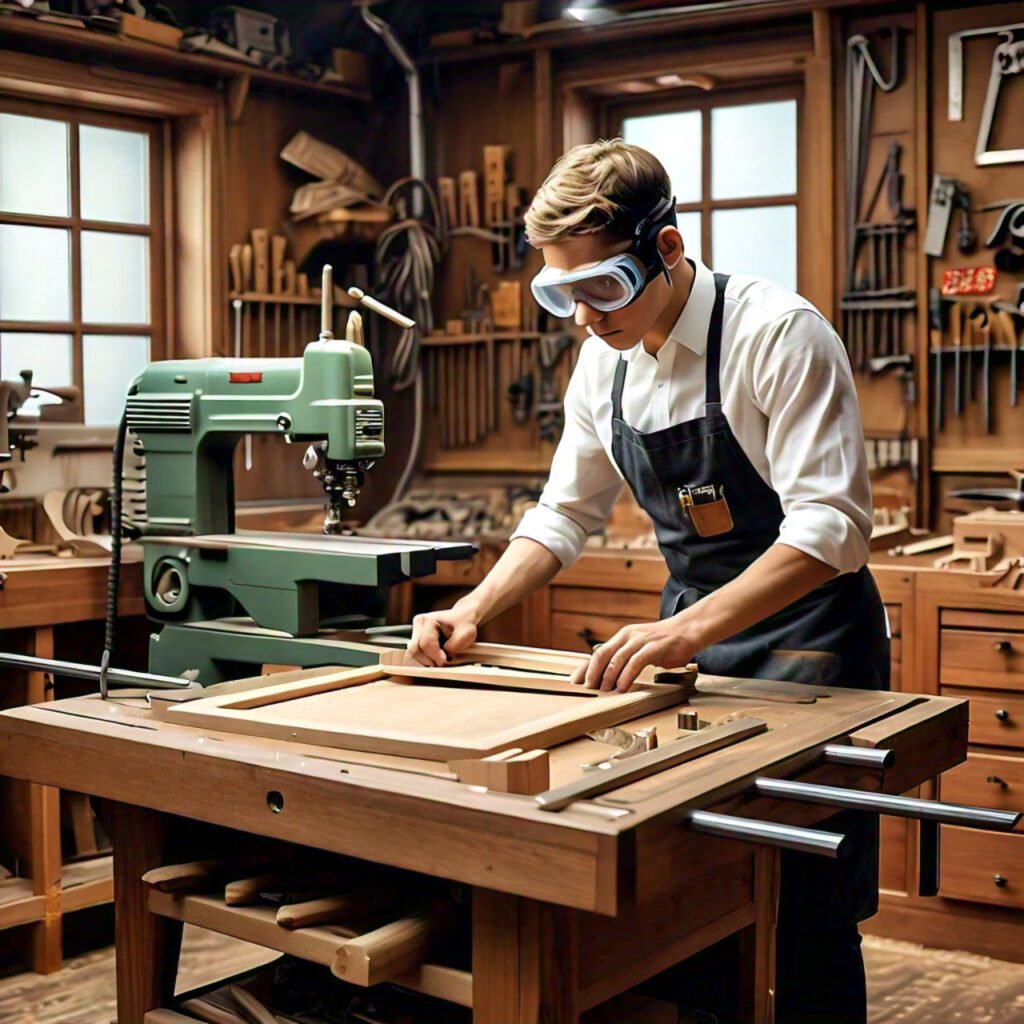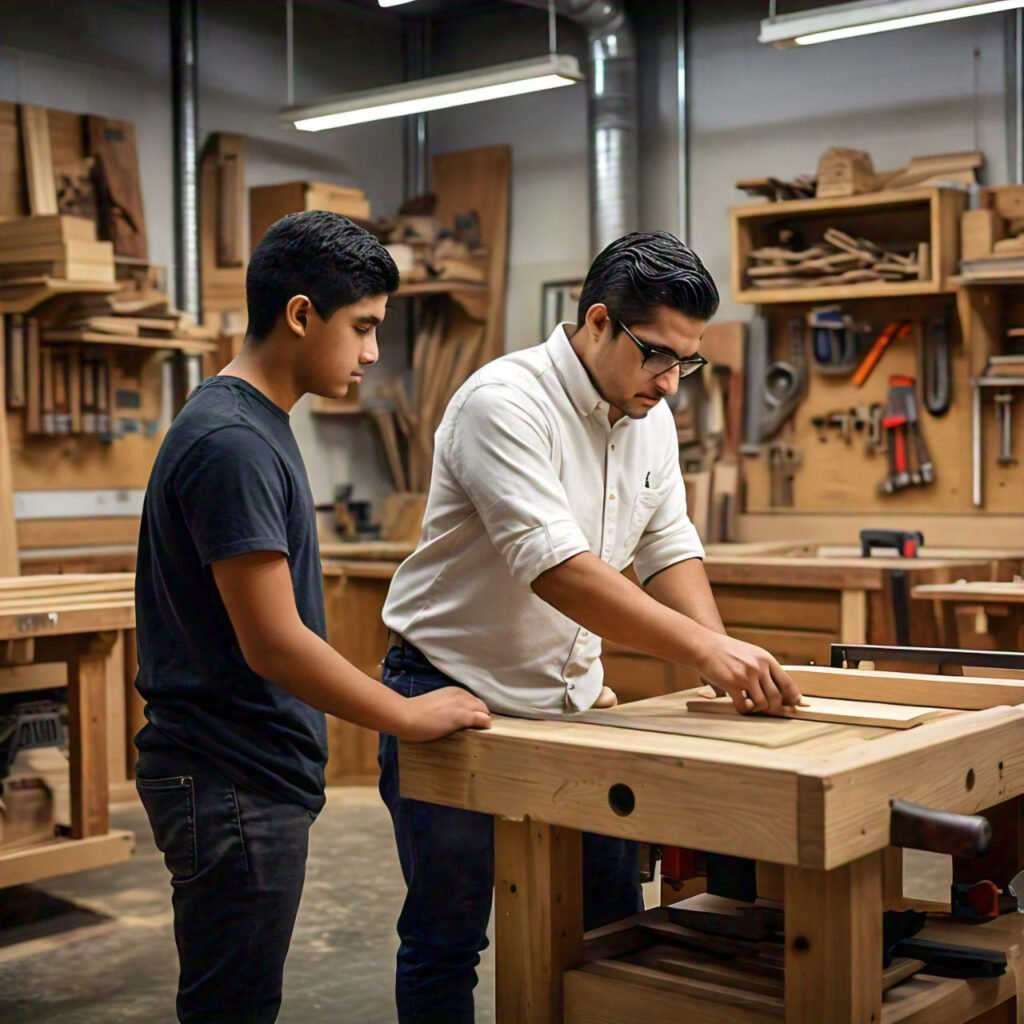Key Takeaways
- Woodworking enhances a gentleman’s skill set and creativity
- Essential tools for beginners include hand saws, chisels, and a workbench
- Safety gear and proper workspace setup are crucial
- Start with simple projects like cutting boards or picture frames
- Precision and patience are key virtues in woodworking
- Sustainable wood sourcing reflects a gentleman’s environmental consciousness
- Finishing techniques elevate the appearance of projects
- Joining a woodworking community can accelerate learning
In the realm of gentlemanly pursuits, few activities rival the satisfaction and artistry of woodworking. This time-honored craft blends creativity with precision, offering a unique avenue for self-expression and the cultivation of invaluable skills. For the modern gentleman seeking to expand his repertoire of talents, woodworking presents an opportunity to connect with tradition while crafting items of lasting beauty and utility. This guide will introduce you to the world of woodworking, focusing on beginner-friendly projects that will set you on the path to becoming a true artisan of wood.

The Gentleman’s Workshop: Setting Up Your Space
The journey into woodworking begins with creating a suitable workspace. A well-organized workshop is the foundation of any woodworking endeavor, reflecting the gentleman’s commitment to order and efficiency.
Choosing the Right Location
Selecting an appropriate area for your workshop is crucial. Ideally, choose a space with ample natural light and good ventilation. A garage, basement, or spare room can be transformed into a woodworking sanctuary. Consider the noise factor and ensure your chosen location won’t disturb others in your household or neighborhood.
Remember, a gentleman respects his surroundings and those who share them. If space is limited, don’t be discouraged. Many woodworkers start with a simple workbench in a corner, gradually expanding their setup as their skills and projects grow.
Essential Tools for the Beginner
Every craftsman needs his tools, and woodworking is no exception. Start with the basics: a quality hand saw, a set of chisels, a sturdy hammer, and a reliable measuring tape. These fundamental tools will serve you well in your initial projects.
As you progress, consider investing in power tools like a drill and a circular saw. However, remember that true craftsmanship lies not in the tools themselves, but in the hands that wield them. A gentleman takes pride in mastering hand tools before relying too heavily on power equipment.
Safety First: The Gentleman’s Approach
A true gentleman values safety above all else. Equip yourself with essential safety gear: protective goggles, ear protection, and a dust mask. These items are non-negotiable and should be worn whenever you’re working with wood.
Establish a safety routine before beginning any project. This includes checking your tools, ensuring proper ventilation, and having a first aid kit nearby. Remember, a gentleman’s workshop is a place of creation, not danger.
Crafting Elegance: Your First Projects
With your workshop set up, it’s time to embark on your woodworking journey. Starting with simple projects allows you to build confidence and hone your skills.
The Classic Cutting Board
A cutting board is an excellent first project. It’s practical, relatively simple, and allows you to experiment with different wood types and patterns. Choose a hardwood like maple or walnut for durability.
Begin by selecting and cutting your wood to size. Sand the surfaces smooth, paying attention to the edges. For added elegance, consider inlaying a contrasting wood strip. Finish with a food-safe oil to protect the wood and enhance its natural beauty.
Picture Perfect: Crafting a Frame
A handcrafted picture frame elevates any photograph or artwork. This project introduces you to miter joints, a fundamental woodworking technique. Select a wood that complements the picture it will hold – perhaps a rich mahogany or a light oak.
Measure and cut your pieces carefully, ensuring perfect 45-degree angles for the corners. Assembly requires patience and precision – hallmarks of a true gentleman craftsman. Once glued and clamped, sand the frame smooth and apply a finish that enhances the wood’s natural grain.
Bookends: Form Meets Function
Bookends offer a blend of practicality and artistic expression. This project allows you to explore curves and shapes while creating something useful for your study or library.
Start with a simple design – perhaps a pair of L-shaped supports. As your skills grow, you can attempt more intricate designs, incorporating elements like inlays or carved details. Remember, even the simplest designs can exude elegance when crafted with care and attention to detail.
The Art of Wood Selection
Choosing the right wood is crucial in woodworking. It affects not only the appearance of your project but also its durability and workability.
Understanding Wood Types
Familiarize yourself with different wood species. Softwoods like pine are great for beginners due to their affordability and ease of working. Hardwoods like oak, maple, and cherry offer beautiful grain patterns and durability but can be more challenging to work with.
Consider the intended use of your project when selecting wood. For items that will see heavy use, like a cutting board, opt for harder woods. For decorative pieces, you might choose woods with interesting grain patterns or colors.
Sustainable Sourcing: A Gentleman’s Responsibility
As a modern gentleman, consider the environmental impact of your woodworking. Seek out sustainably sourced wood from reputable suppliers. Using reclaimed wood not only gives new life to old materials but also adds character and history to your projects.
Be mindful of exotic woods. While beautiful, some may be sourced from endangered forests. A true gentleman balances his desires with environmental stewardship.
Reading the Grain
Understanding wood grain is essential for successful projects. The grain affects how the wood cuts, sands, and takes finish. Learn to identify straight grain, which is easier to work with, versus figured grain, which can be more challenging but offers stunning visual appeal.
Practice reading grain patterns before making cuts. This skill will help you make informed decisions about how to orient your wood for both structural integrity and aesthetic appeal.
Essential Techniques for the Aspiring Woodworker
Mastering basic woodworking techniques is crucial for any gentleman embarking on this noble craft. These skills form the foundation upon which all your future projects will be built.
The Art of Measuring and Marking
Precision is the hallmark of fine woodworking. Learn to measure accurately and mark your cuts clearly. Use a sharp pencil or marking knife for precise lines. Remember the adage: “Measure twice, cut once.” This attention to detail will set your work apart.
Invest in quality measuring tools – a combination square, marking gauge, and tape measure are essential. Practice using these tools until their use becomes second nature. A gentleman’s work is characterized by its accuracy and consistency.
Cutting with Confidence
Developing proper cutting techniques is crucial. Whether using hand saws or power tools, maintain a steady hand and a consistent pace. Let the tool do the work – forcing the cut can lead to mistakes or even injuries.
Practice different types of cuts – straight cuts, curves, and joinery cuts. Each has its nuances. Start with softwoods to build your confidence before moving on to harder species. Remember, patience is a virtue in woodworking as in life.
Joinery: The Heart of Woodworking
Joinery is where woodworking truly becomes an art form. Begin with simple joints like butt joints and rabbets. As your skills progress, move on to more complex joinery such as dovetails and mortise and tenon joints.
Each joint has its purpose and aesthetic appeal. Understanding when and how to use different joints will elevate your projects from simple to sophisticated. Practice these techniques on scrap wood before incorporating them into your projects.
Finishing Touches: Elevating Your Creations
The finish you apply to your woodworking projects can make or break their final appearance. It’s the last step, but perhaps the most crucial in terms of aesthetics and protection.
Choosing the Right Finish
There’s a wide array of finishes available, each with its own characteristics. Oil finishes like linseed or tung oil penetrate the wood, enhancing its natural beauty. Varnishes and polyurethanes offer more protection but can alter the wood’s appearance.
Consider the project’s intended use when selecting a finish. A cutting board requires a food-safe finish, while a decorative piece might benefit from a high-gloss varnish. Experiment with different finishes on scrap wood to see how they interact with different wood species.
The Art of Sanding
Proper sanding is essential for a smooth finish. Start with coarse-grit sandpaper and progressively move to finer grits. Sand with the grain to avoid scratches. Take your time – rushing this step will be evident in the final product.
Between coats of finish, use ultra-fine sandpaper or steel wool to achieve a glass-like smoothness. This attention to detail is what separates a gentleman’s work from the ordinary.
Applying the Finish
Applying finish is a skill in itself. Whether brushing, wiping, or spraying, maintain a clean, dust-free environment. Apply thin, even coats, allowing proper drying time between applications.
Be patient during this process. A well-applied finish can elevate a simple project to a work of art. Remember, the final coat is your signature on the piece – make it count.
Tools of the Trade: Building Your Arsenal
As you progress in your woodworking journey, you’ll want to expand your toolkit. Here’s a list of tools to consider adding to your workshop:
- Clamps in various sizes
- A quality workbench
- Hand planes for smoothing surfaces
- A router for edge work and decorative details
- A table saw for precise cuts
- Chisels of various sizes
- A drill press for accurate holes
- Sandpaper in various grits
- Wood glue and wood filler
- A set of quality brushes for applying finishes
- A moisture meter to check wood humidity
- Safety equipment including dust collection system
- Sharpening stones for maintaining your tools
- A set of wood carving tools for detailed work
- A lathe for turning projects

The Gentleman’s Guide to Wood Types
Choosing the right wood for your project is crucial. Here’s an overview of common wood types and their characteristics:
Softwoods
Softwoods are generally easier to work with and more affordable, making them ideal for beginners.
Pine: Light in color and weight, pine is easy to work with and takes stain well. It’s perfect for practice projects and rustic-style furniture.
Cedar: Known for its pleasant aroma and natural resistance to decay, cedar is excellent for outdoor projects and closet linings.
Hardwoods
Hardwoods offer durability and beautiful grain patterns, though they can be more challenging to work with.
Oak: Strong and durable with a prominent grain, oak is ideal for furniture and flooring. It stains well and is resistant to wear and tear.
Maple: Hard and dense, maple is excellent for cutting boards and butcher blocks. It has a subtle grain and takes finishes well.
Cherry: Prized for its reddish-brown color that deepens over time, cherry is popular for fine furniture and cabinetry.
Woodworking Etiquette: The Gentleman’s Approach
A true gentleman approaches woodworking with respect for the craft, the materials, and fellow artisans. Here are some etiquette guidelines:
- Respect the wood: Choose your materials thoughtfully and use them wisely.
- Maintain your tools: Keep your tools clean and sharp. A gentleman’s tools reflect his character.
- Share knowledge: Be willing to learn from others and share your own insights.
- Practice patience: Rushing leads to mistakes. Take your time and enjoy the process.
- Clean up after yourself: A tidy workshop is a sign of a disciplined mind.
- Be humble: There’s always more to learn in woodworking.
- Respect copyrights: Don’t copy others’ designs without permission.
- Use sustainable practices: Consider the environmental impact of your hobby.
- Safety first: Never compromise on safety for yourself or others.
- Appreciate craftsmanship: Recognize and admire quality work, whether your own or others’.

Inspirational Woodworkers Through History
Drawing inspiration from master craftsmen can elevate your woodworking journey. Here are some notable figures in woodworking history:
Thomas Chippendale
Thomas Chippendale, an 18th-century English cabinetmaker, revolutionized furniture design. His book “The Gentleman and Cabinet Maker’s Director” became a standard for elegant furniture design.
Chippendale’s work exemplified the fusion of functionality with artistic flair. His designs, characterized by intricate carvings and graceful lines, continue to inspire woodworkers today. As a gentleman woodworker, studying Chippendale’s techniques can provide valuable insights into creating pieces that are both beautiful and practical.
George Nakashima
George Nakashima, a 20th-century American woodworker, was known for his organic, naturalistic approach to furniture design. He saw each piece of wood as unique, often incorporating the tree’s natural edges into his designs.
Nakashima’s philosophy of respecting the inherent beauty of wood aligns perfectly with the gentleman’s approach to craftsmanship. His work teaches us to see beyond the surface, finding beauty in imperfections and honoring the natural characteristics of our materials.
Sam Maloof
Sam Maloof, another 20th-century American woodworker, was renowned for his rocking chairs. His designs combined functionality with sculptural beauty, creating pieces that were both works of art and comfortable furniture.
Maloof’s dedication to his craft and his innovative joinery techniques serve as an inspiration to all aspiring woodworkers. His approach reminds us that true craftsmanship lies in creating pieces that are not only visually appealing but also serve their intended purpose with excellence.
The Gentleman’s Woodworking Library
Building a collection of woodworking books can greatly enhance your knowledge and skills. Here are some essential titles for your library:
- “Understanding Wood” by R. Bruce Hoadley
- “The Complete Manual of Woodworking” by Albert Jackson and David Day
- “The Anarchist’s Tool Chest” by Christopher Schwarz
- “The Essential Woodworker” by Robert Wearing
- “The Workbench Book” by Scott Landis
- “The Unplugged Woodshop” by Tom Fidgen
- “The Why & How of Woodworking” by Michael Pekovich
- “Woodworking Wisdom & Know-How” by Taunton Press
- “The Toolbox Book” by Jim Tolpin
- “The Art of Japanese Joinery” by Kiyosi Seike
These books cover everything from wood properties and tool usage to advanced techniques and project ideas. Remember, a gentleman never stops learning, and these resources will prove invaluable as you progress in your woodworking journey.
Woodworking Communities: Expanding Your Network
Joining a woodworking community can greatly enhance your skills and enjoyment of the craft. Here are some ways to connect with fellow enthusiasts:
Local Woodworking Clubs
Many cities have woodworking clubs where members share knowledge, tools, and workspace. These clubs often organize workshops, group projects, and exhibitions. Joining such a club allows you to learn from experienced craftsmen and share your own insights.
Participating in a local club also provides opportunities to contribute to community projects, embodying the gentleman’s spirit of service through your craft.
Online Forums and Social Media Groups
The internet has made it easier than ever to connect with woodworkers worldwide. Platforms like Reddit’s r/woodworking or Facebook woodworking groups offer spaces to share projects, ask questions, and discuss techniques.
Engaging in these online communities allows you to tap into a vast pool of knowledge and experience. Remember to approach these interactions with the same courtesy and respect you would in person.
Woodworking Classes and Workshops
Many community colleges, woodworking stores, and private instructors offer classes for all skill levels. Attending these can provide hands-on experience under expert guidance.
As a gentleman woodworker, consider not only taking classes but also offering to teach once you’ve gained expertise. Sharing knowledge is a noble way to give back to the community that has nurtured your skills.

Sustainable Woodworking: A Gentleman’s Responsibility
In today’s world, practicing sustainable woodworking is not just admirable – it’s essential. Here are some ways to make your woodworking more environmentally friendly:
Use Reclaimed Wood
Incorporating reclaimed wood into your projects not only reduces demand for new timber but also adds character and history to your work. Look for sources of reclaimed wood in your area, such as old barns or demolished buildings.
Working with reclaimed wood often requires extra effort in cleaning and preparing the material, but the results can be stunning. It’s a testament to a gentleman’s commitment to both craftsmanship and environmental stewardship.
Choose Sustainable Species
When purchasing new wood, opt for species that are sustainably harvested. Look for certifications from organizations like the Forest Stewardship Council (FSC) which ensure the wood comes from responsibly managed forests.
Consider using fast-growing species like bamboo or locally sourced woods to reduce the environmental impact of transportation.
Minimize Waste
Efficient use of materials is a hallmark of skilled craftsmanship. Plan your cuts carefully to maximize the use of each board. Save offcuts and scraps for smaller projects or to create unique inlays and accents in future work.
Consider donating usable scraps to schools or community centers for their woodworking programs. This not only reduces waste but also supports woodworking education in your community.
Summary Table
| Aspect | Beginner | Intermediate | Advanced |
|---|---|---|---|
| Tools | Hand saws, chisels, sandpaper | Power tools, router, table saw | Specialized tools, lathe, CNC machine |
| Projects | Cutting boards, picture frames | Small furniture, boxes | Complex furniture, artistic pieces |
| Skills | Basic cuts, sanding | Joinery, finishing techniques | Advanced joinery, design, restoration |
| Wood Types | Softwoods (pine, cedar) | Hardwoods (oak, maple) | Exotic woods, reclaimed materials |
| Workspace | Small corner or workbench | Dedicated room or garage | Fully equipped workshop |
| Safety Gear | Goggles, dust mask | Respirator, hearing protection | Dust collection system, ergonomic setup |
Conclusion
The journey of a gentleman woodworker is one of continuous learning, refinement, and personal growth. As you progress from your first simple projects to more complex creations, you’ll find that woodworking offers not just the satisfaction of creating beautiful and functional objects, but also a path to developing patience, precision, and a deep appreciation for craftsmanship.
Remember that true mastery in woodworking, as in all gentlemanly pursuits, comes not from the tools you use or the complexity of your projects, but from the care, attention, and respect you bring to your craft. Each piece you create is a reflection of your character, a tangible embodiment of the time-honored virtues of diligence, creativity, and respect for tradition.
As you continue on this noble path, let your workshop be a sanctuary where the hustle of modern life fades away, replaced by the timeless rhythms of sawing, chiseling, and sanding. May each project you undertake be an opportunity to leave a lasting mark of beauty and functionality in the world, a testament to the enduring value of craftsmanship in our fast-paced age.
Frequently Asked Questions
What are the essential tools for a beginner woodworker?
Essential tools for beginners include a quality hand saw, chisels, a hammer, measuring tape, and sandpaper. As you progress, consider adding a drill, circular saw, and workbench to your arsenal. Remember, it’s not about having every tool, but mastering the ones you have.
How can I ensure safety in my woodworking workshop?
Safety should always be your top priority. Invest in proper safety gear including goggles, ear protection, and a dust mask. Keep your workspace clean and well-organized. Always read and follow tool instructions carefully, and never work when tired or distracted. A gentleman values his well-being and that of others above all else.
What’s the best wood for beginner projects?
Softwoods like pine or cedar are excellent for beginners due to their affordability and ease of working. As you gain confidence, you can move on to hardwoods like oak or maple. Each wood type has its characteristics, so choose based on your project’s requirements and your skill level.
How do I maintain my woodworking tools?
Proper tool maintenance is crucial for both performance and longevity. Clean your tools after each use, removing any dust or debris. Keep cutting tools sharp – dull tools are not only inefficient but also dangerous. Store tools in a dry place to prevent rust. Regularly oil moving parts on power tools. A gentleman takes pride in the condition of his tools.
What’s the importance of wood grain in woodworking?
Understanding wood grain is essential for successful projects. The grain affects how wood cuts, sands, and takes finish. Working with the grain usually yields better results. It also impacts the strength and appearance of your finished piece. Learning to read and work with grain patterns is a key skill for any woodworker.
How can I improve my precision in woodworking?
Precision comes with practice and patience. Always measure twice before cutting. Use sharp pencils or marking knives for accurate lines. Invest in quality measuring tools and learn to use them effectively. Take your time with each cut and don’t rush the process. Remember, a gentleman’s work is characterized by its accuracy.
What are some eco-friendly practices in woodworking?
To practice sustainable woodworking, consider using reclaimed wood or sustainably sourced timber. Minimize waste by planning cuts carefully and using scraps for smaller projects. Choose finishes with low volatile organic compounds (VOCs). Proper dust collection not only keeps your workspace clean but also reduces environmental impact.
How can I develop my own style in woodworking?
Developing your style takes time and experimentation. Start by mastering basic techniques and then begin to incorporate your own ideas. Draw inspiration from various sources – nature, architecture, other woodworkers – but always add your personal touch. A gentleman’s style in woodworking, as in life, is a reflection of his unique character and experiences.

Gabrielle J. Smith is our multitasking superstar at Skilled Gentlemen. As an HR expert, she nurtures our team’s well-being, while her blog posts captivate our readers with enchanting stories and gift ideas.
